Home | Next |
Index | Purchase book
Idaho Mountain Wildflowers
The Parsley or Carrot Family: Apiaceae
(page 1 of 3)
The scientific names, Umbelliferae and Apiaceae are both acceptable,
although the latter is preferred today by most botanists. There are about
440 genera and 3,590 species in the family. Most are non-woody. Typically
their stems are thick and often hollow and the leaves wrap, or sheath about
the main stem, as in celery or fennel plants. Small flowers are arranged
in flat-topped clusters; the resulting inflorescence resembles the ribs of
an inside-out umbrella, the origin of the older family name, Umbelliferae.
In some species the flowers heads are compound; i.e., each stemlet divides
further. The flowers themselves are almost always radially symmetrical with
five small sepals and five petals, although it may take a magnifying glass
to make out these details. Some of the genera contain many similar species,
so identification can be difficult. The family is valued mostly for its edible
plants: carrots, celery, fennel, chervil, parsley, parsnip, etc., and herbs,
including coriander, cumin, caraway, dill, and angelica. It is unwise to
eat wild umbellifers unless their identification is certain—several
are extremely poisonous. The family name “Apiaceae” was derived
from apium, the Latin word for parsley.
 |
Lyall’s angelica, Angelica
arguta Nutt. (left and right), grows to treeline, blooming
from midsummer on along mountain streams and in wetlands. The name angelica
was derived from supposed medicinal properties disclosed by an angel. Our
species name, arguta, means “sharp-toothed” for the shape
of the compound pinnate leaves. The leaf-bearing stems angle outward about
20 degrees further at the nodes, where the leaves come off, an identifying
feature. David Lyall (1817-1895), whose name is associated with this plant
(formerly known as Angelica lyallii) was an assistant surgeon and
botanist on Captain James Ross’s voyage of exploration (1839-1844) to
the northern Pacific and arctic regions. Lewis and Clark also collected an
angelica (probably this species) along the Lolo Trail in northern Idaho
on their outbound journey in 1805 and again on their return journey in 1806.
|
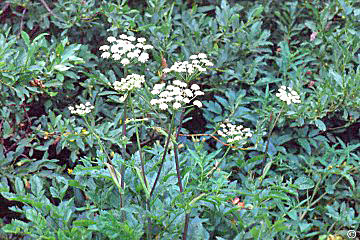 |
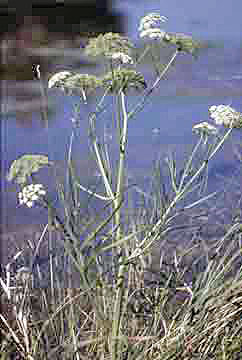
|
The Northern (or common) yampah,
Perideridia montana (Blank.)
Dorn (left) blooms in mid-summer, or later, on the banks of mountain
streams. It is a likely the edible plant—“a speceis [sic] of
fennel”—that Meriwether Lewis (1774-1809) saw Indian women harvesting
on August 26th near the Lemhi Pass on today’s Idaho-Montana border (where,
interestingly, yampah is no longer found). If he collected a specimen it
did not survive the journey, for yampah is not represented in the Lewis and
Clark Herbarium in Philadelphia.
Slender leaved lovage, Ligusticum
tenuifolium S. Watson, (right) also known
as “licorice root,” grow to subalpine elevations in our mountains.
Dainty umbels of white flower heads are borne atop tall stems, often after
the basal leaves have disappeared. Pinnate (feather-like) compound leaves
with narrow, divided leaflets explain the species name, tenuifolium
(“slender leaf”). As with several other umbellifers, the roots
and seeds have a distinctive odor as reflected in the name “licorice
root.” This plant was used by Native Americans for flavoring.
|
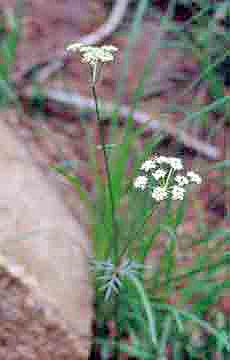 |
 |
Swamp White-heads (also Rangers’ Buttons and
Woolyheaded parsnip) Sphenosciadium
capitellatum A.
Gray (left, right)
stand three or four feet high along streams and in moist meadows
from foothills to mountain valleys, blooming in mid- to late summer.
This is the only species in the genus Sphenosciadium. It is
identified by its woolly flowerheads, each made up of many tiny flowers.
These (right) are usually white, but sometimes have a pinkish tinge.
The leaves are compound, made up of three or more parts. The scientific name
is derived from the Greek words sphena meaning “wedge,”
and skiada for “parasol,” referring respectively to
its wedge shaped fruits and the plant’s umbels. The species’ name,
capitellatum, means “little heads.” |
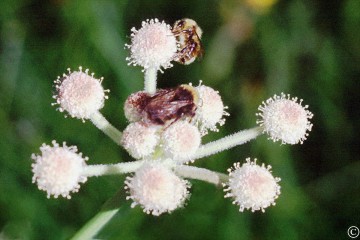 |
 |
Western water-hemlock, Cicuta
douglasii (DC.) J. M. Coult. & Rose
(left, right) is not a food plant. The related European
hemlock, Conium maculatum L., also grows throughout the United States).
It was the plant that poisoned Socrates. Ours is also extremely poisonous.
It is a handsome plant with dark green, shiny, three-parted, serrated leaves.
Clusters of muddy-white flowers resemble exploding fireworks. The plant grows
along streams, and in moist meadows as high as treeline. The stems are hollow
and are perfect for making whistles—the poison reportedly has killed
children who did so. It has also been the murder plant of choice in more
than one detective novel. The Latin word Cicuta originally referred
to a now unidentifiable poisonous member of the parsley family—possibly
the European hemlock mentioned above. The species name commemorates David
Douglas (1798-1834), he of the fir tree, who introduced more North American
plants into English gardens than any other plant hunter. |
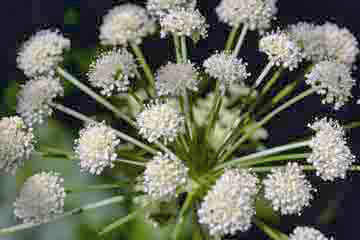 |
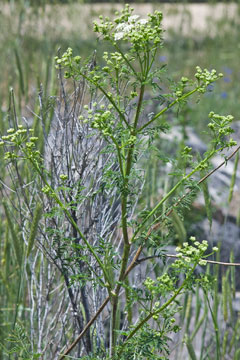 |
Poison hemlock, Conium maculatum
L. is the Eurasian hemlock mentioned above. It is a common
plant now found throughout the United States and all but the northernmost
provinces of Canada, usually on moist ground, in settled areas. It is tall,
frizzy-leaved, and hollow-stemmed. The plants grow to be 5 feet or more high.
Its species name, maculata, means "spotted" referring to reddish-brown
spots on the plant's main stem; the generic name, Conium, is the name
the ancient Greeks gave to this plant. Given how poisonous it is--the poison
is a neurotoxin that affects respiration--it is surprising that there are
few accounts of children being poisoned. It is not surprisingly that the
poison hemlock is listed as a noxious plant in many states including
Idaho. |
Home | Next |
Index | Purchase book








